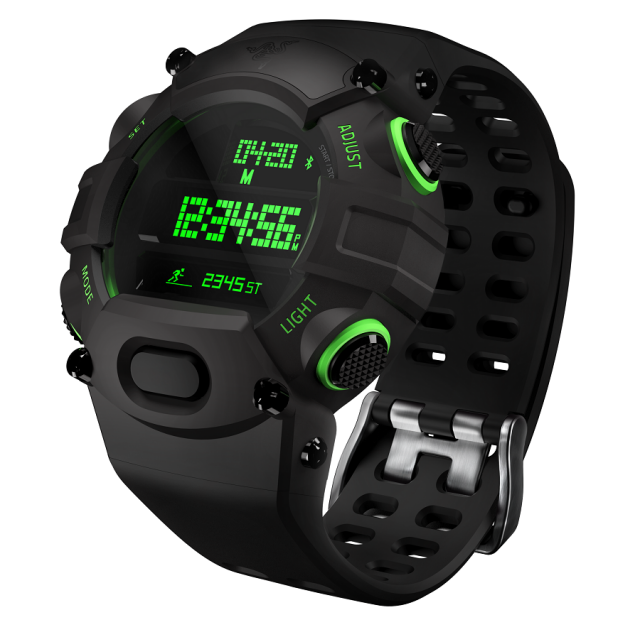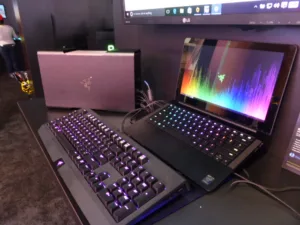Razer has a reputation for innovation. At previous CES shows, the company has shown products such as a gaming tablet (with joysticks and a Core i7 processor), a modular PC for consumers without the technical knowledge to build their own and a set-top box that can stream PC games to a TV. This year’s announcements were not quite as left-field, but were still interesting.
The Razer Blade gaming laptop was launched several years ago, and the company has been updating it with new versions ever since. However, the need to gear the product towards high-end PC gaming put strict limits on the size of the device.
Razer has overcome this with two new products: the Razer Blade Stealth and Razer Core. The Stealth is this year’s iteration on the Blade, with a 12.5″ display. An IPS panel is used in the display (2560 x 1440 or UltraHD), which would normally have received criticism from gamers for the longer response time compared to TN. However, Razer has got around this problem by using IGZO TFTs.
The Stealth has a 60Hz refresh rate and touch. It runs Windows on a Skylake Core i7 processor, with 8GB of RAM and up to a 512GB SSD. The main port is USB-C with Thunderbolt 3, which carries data, video, audio and power. Two USB 3.0 inputs are also featured. Measuring 13.2mm high and weighing 1.24kg, it is the smallest Blade to date.
The key behind the small size is the use of integrated graphics, rather than a discrete GPU, which impacts the graphical performance of the device. However…
Razer has introduced the Core, an external graphics card holder that is compatible with ‘virtually every’ popular GPU from AMD and Nvidia – including double-wide PCIe units. The Core connects to the Blade Stealth through the USB-C (Thunderbolt 3) port and significantly boosts the ultrabook’s gaming potential. It is much like Alienware’s Graphics Amplifier (Display Monitor Vol 21 No 43).
In addition to holding a GPU, the Core adds four additional USB 3.0 ports and an RJ45 port. Prices have not been announced yet, although Razer has shared pricing for the ultrabook. It will start at $1,000, with the most expensive variant costing $1,600.
One to Watch
 The Nabu wristband is a fitness tracker first seen at CES 2013, and Razer has tweaked the technology by integrating it into a new product called the Nabu Watch: ‘Not a smartwatch, but a watch that’s smart’.
The Nabu wristband is a fitness tracker first seen at CES 2013, and Razer has tweaked the technology by integrating it into a new product called the Nabu Watch: ‘Not a smartwatch, but a watch that’s smart’.
As well as acting as a watch (naturally), the Nabu Watch has a secondary passive OLED screen (128 x 16), which previews notifications from a smartphone. The screen also shows tracked fitness and sleep activity.
Rather than focusing on apps, making calls and other functions, the main digital display simply acts as a (very accurate, being synced to a smartphone) chronograph. It will last for 12 months using the coin cell replaceable battery, while the secondary screen will last for seven days using a separate rechargeable battery. This does mean that the Watch is large, compared to some other such devices.
Like other Nabu devices, someone wearing the Nabu Watch is able to exchange Facebook and Twitter contact information with another Nabu wearer, by shaking hands. The Watch will be available this month, starting at $150.
The final new product was a webcam called the Stargazer, which uses Intel’s Realsense technology. Because it is designed for gamers, the primary use of the webcam is as a streaming tool.
Streaming can be expensive, requiring high-quality cameras and green screens to remove the background. However, the Realsense technology is able to do this dynamically, by tracking the user and inserting only their face and body into the game. The unit, which clips to the top of a monitor, contains three cameras and can capture 720p video at 60fps, or 1080p at 30fps. As well as streaming, the camera can also be used with Windows Hello, for gesture recognition and other applications such as Skype.
Razer will release the Stargazer webcam worldwide in Q2, for $200.
The OSVR headset – an open-source VR headset, which was previewed last year (Razer Strikes Nvidia’s Shield) – was on show again. Development has not significantly moved forward – pixels are still clearly visible on the 1080p screen – but the depth and sharpness of content had been improved. The headset, as an open-source device, will be moddable, so the screen could be replaced with dual displays if a user desires.

